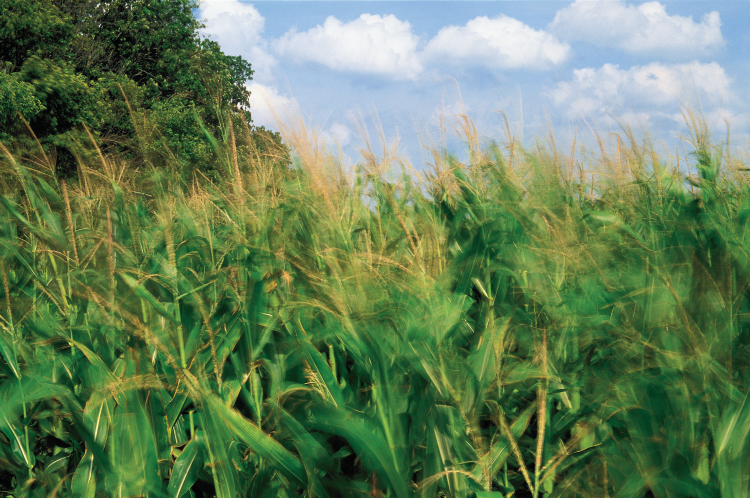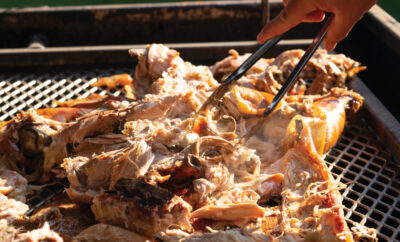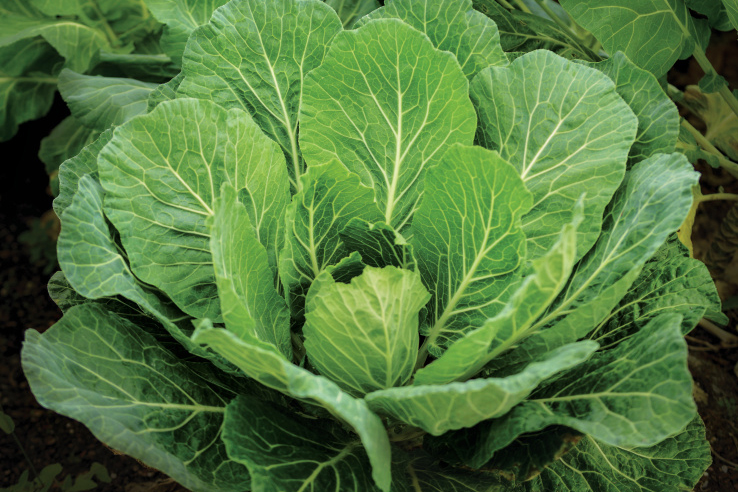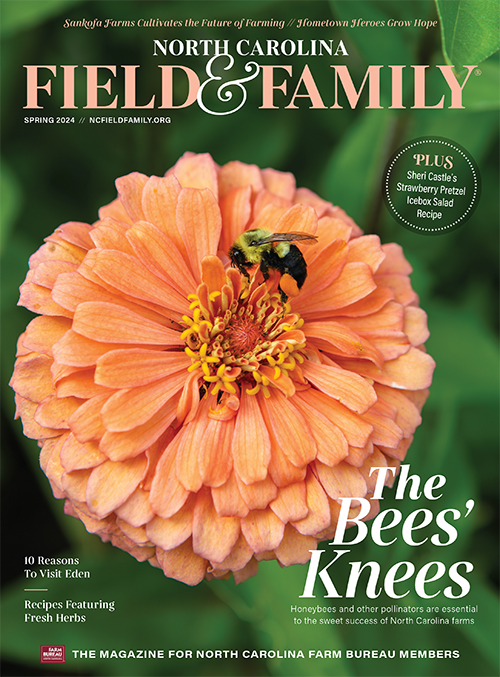Farmers, Researchers Work to Keep Pests Out of Crops

Corn crops in North Carolina can be destroyed by pests, such as armyworms, without proper pest management.
Nowadays the effectiveness of scarecrows might be pretty limited with the number of creatures that can wreak havoc on the many crops produced in North Carolina. The most predominant place a scarecrow might be found is at county 4-H competitions that test youngsters’ creativity.
Pesticides are vital tools for managing pests that reduce crop yield and quality, spread disease, congest waterways or jeopardize quality of life.
State and federal pesticide laws require applicators to be certified by passing one or more examinations about pesticides and their safe use. In addition, North Carolina farmers are required to participate in regular training on how to properly use pest management tools.
It’s an ongoing battle – something Wilkes County Farm Bureau member Clark Mastin learned firsthand this year.
Mastin works on a small family farm, one that previously grew chickens but now uses the land to cultivate wheat and soybeans, as well as corn for production silage for beef cattle. Last year, Mastin had one of his best corn crops ever, producing 30 tons of cattle feed per acre.

Wilkes County Farm Bureau member Clark Mastin examines his corn before harvest in mid-September.
This summer, with high hopes for an even higher yield, Mastin noticed a worm chewing up a corner of a cornfield.
A scarecrow wasn’t going to solve this problem. Resources associated with North Carolina’s Cooperative Extension from Wilkesboro to Raleigh were called into action. It took a few weeks to identify the problem – an armyworm that veteran farmers in the county hadn’t seen in years, if ever.
By the time the problem had been pinpointed, the corn was too mature to spray with a conventional tractor-pulled machine. Only a helicopter could be used, and the cost of that method heavily outweighed the benefits.
“Ours was already tassled and silking,” Mastin says. “As tall as the corn was, it would have been hard to get the chemicals in where we needed them, especially during the day because the worms would have gone either into the soil or hide in the whirls of the stock.
“We just had to stand by and watch it happen,” he adds. “We’ve never had any bug problems whatsoever. Maybe an occasional worm, but nothing hard hit like this. This was new to us and several people in the area.”
What was it like to see worms chew up close to 4 acres of corn destined for a buyer already lined up before the crop was even planted?
“It was pretty frustrating,” Mastin says. “We spend a lot of money to be able to put it in the ground. There’s a whole lot of preparation. Every farmer always puts every bit of hope and trust that it’s going to come out the most perfect crop he’s ever had. Sometimes you get your expectations up because last year we were coming off a great year.”
To prevent a repeat next year, Mastin says he’s already working with Wilkes County Cooperative Extension Agent John Cothern, who also spearheaded the investigation that led to the full identification of the pest. Mastin intends to use an extra round of approved pesticide on his cropland this fall.
“When you’re looking at over $200 for a bag of corn and fertilizer is at an all-time high, everything just costs so much so farmers just have to be very efficient at what they’re doing,” Cothern says. “It’s not just about hitching the corn planter to the tractor and saying, ‘Let’s go plant corn today.’ Now there is so much technology involved. You have to pick a certain variety that’s going to do well in your region. And sometimes those varieties prevent those insects and diseases from coming upon the crop,” he adds. “It’s a very technological world we’re in, especially in farming. It’s just amazing. You can never let your guard down. You’re always looking at preventive measures. Like they say, an ounce of prevention is worth a pound of cure.”
| Pesticide Environmental Trust Fund |
In 1993, the N.C. General Assembly enacted legislation creating the Pesticide Environmental Trust Fund (PETF). This law requires companies registering pesticide products in North Carolina to pay an additional environmental assessment fee for each brand registered with the N.C. Department of Agriculture & Consumer Services. Companies pay $25 for products with annual sales less than $5,000 and $50 for products with annual sales $5,000 or greater. Fees are deposited into the department’s Pesticide Environmental Trust Fund.The purpose of the fund is for those pesticide-related environmental programs administered by NCDA&CS. The authority to use these funds is directed by the N.C. Pesticide Board. The department will consider projects for PETF funding based on the following criteria:
|
Training to Use Pesticides
Pesticides are classified by the U.S. Environmental Protection Agency (EPA) as either general-use or restricted-use.
North Carolina Cooperative Extension officials say restricted-use pesticides have a greater potential to harm humans, the environment, or both. Only a certified pesticide applicator or someone who works under his or her supervision may apply restricted-use pesticides.
There are two classifications of certified applicators: private and commercial. To become certified in North Carolina, applicators must score 70 percent or higher on the appropriate closed-book, multiple-choice exam or exams.
The North Carolina Pesticide Law of 1971 further requires licensing of any individual who is compensated to apply any pesticide (whether restricted-use or general-use) to someone else’s property, any public operator and any golf course operator. Pest control consultants and dealers who sell restricted-use pesticides also must be licensed.
Cooperative Extension conducts two-day pesticide schools to prepare prospective applicators for the private and commercial applicator certification exams.
Future of Pesticide Use
Julia Kornegay, a professor of horticultural science at North Carolina State University, says that improving the sustainability of agriculture not only in this state, but throughout the U.S., requires broad, transformational shifts in market structure, policy incentives and the type and availability of scientific knowledge.
Kornegay describes agriculture as at a crossroads.
“Farms must provide abundant and affordable food, feed, fiber and fuel, yet their economic viability is threatened by numerous factors, including but not limited to dwindling resources, climate change and market volatility,” Kornegay says.
“With the multiple constraints we face, we can’t rely solely on incremental changes to existing farming systems to improve the sustainability and productivity of U.S. agriculture,” she adds. “To increase agriculture resilience and productivity with less water, fertilizer and pesticides, we need to look at agriculture as an agroecosystem at both the farm and landscape level, and maximize the use of natural resources like soil fertility and organic matter to provide better water-holding capacity, nutrients, and disease management.”
Kornegay recently compiled a report for the National Academy of Sciences and the National Research Council that took a comprehensive look at the challenges faced by U.S. agriculture—including population growth, water and land scarcities, cost of energy and fertilizers, and other factors.
“Our study looked at a number of farms across the U.S. that have successfully implemented a wide variety of sustainable farming practices. In fact, much of the innovation in sustainable agriculture systems is coming from farmers,” Kornegay says.












 North Carolina Field and Family magazine highlights farms and foods, events and attractions, and interesting people and places throughout the state.
North Carolina Field and Family magazine highlights farms and foods, events and attractions, and interesting people and places throughout the state.
Ned M. Ahdoot
August 18, 2014 at 11:16 pm
Dear Sir
We have invented a new technology in imaging for identification of pests in a farm.
Would you tell us what it will cost to put an ad in your magazine let us say one or 1/2 page
Thank you
Ned M. Ahdoot
310-738-9947
Jessy Yancey
September 5, 2014 at 10:09 am
Hi Ned,
For more information about advertising, please visit ncfieldfamily.org/advertising. I will also pass along your request for information to Herb Harper. Thanks!
Jessy Yancey
editor, ncfieldfamily.org